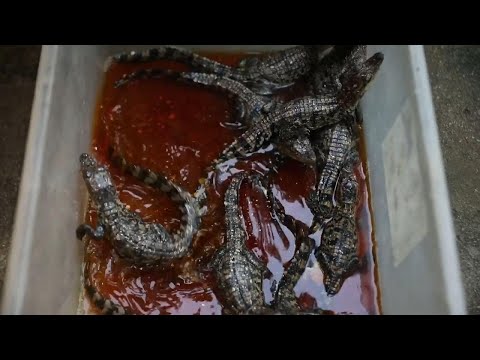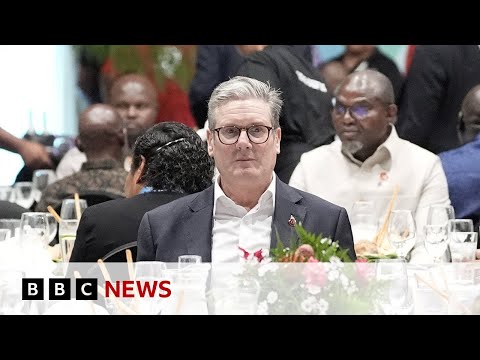(23 Oct 2024)
RESTRICTION SUMMARY
ASSOCIATED PRESS
Phnom Tamao – 12 July 2024
1. Various of baby Siamese Crocodiles hatching from eggs
2. Wide of eggs in hatching box
3. Two baby crocodiles lying next to each other
4. Sequence of hand removing a baby and placing it in the container with its siblings
5. Baby crocodiles in container, seen from side
ASSOCIATED PRESS
Phnom Penh – 6 August 2024
6. SOUNDBITE (English) Pablo Sinovas, Fauna and Flora:
“We are seeing that this is actually working. With recent findings in the wild, we are finding that more and more nests and more hatchlings are being produced. We are still far from being able to say that the species is in a good place but it’s making progress.”
ASSOCIATED PRESS
Phnom Tamao – 4 August 2024
7. Wide of a Siamese Crocodile’s snout on surface of water, then disappearing
8. Wide of crocodile basking
9. Close-up of crocodile basking
10. Wide of a crocodile wallowing in mud
11. Several crocodiles close up beside each other
ASSOCIATED PRESS
Siem Reap – 9 August 2024
12. Mid of crocodile as its head slips beneath the water
13. Wide of crocodile with its mouth agape
14. Close-up of same crocodile
ASSOCIATED PRESS
Phnom Penh – 6 August 2024
15. SOUNDBITE (English) Pablo Sinovas, Fauna and Flora:
“In farms, Siamese crocodiles often hybridize with other species of crocodiles. For example, saltwater crocodiles or even Cuban crocodiles and so we have worked with the Royal Zoological Society of Scotland and the Royal University of Phnom Penh to undertake genetic testing of crocodiles sourced from farms so we are able to determine which individuals are purebred Siamese crocodiles and those are the ones we use in the conservation breeding programme”
ASSOCIATED PRESS
Phnom Tamao – 12 July 2024
16. Wide of sign for breeding center
17. Wide of zookeeper walking in and removing lid of egg box
18. Various of baby crocodiles hatching
ASSOCIATED PRESS
Phnom Penh – 30 July 2024
19. SOUNDBITE (English) Iri Gill, Chester Zoo:
“Once the animals get through their breeding season, they’ll lay eggs and the eggs are artificially incubated. So these are artificial conditions that are replicating nests where the eggs are moved into. And that’s the key stage really, to hatch those juveniles out, rear them on to a strong age before they’re released”
ASSOCIATED PRESS
Cardamom Mountains – 15 March 2024
20. Wide of river in Cardamoms
21. Mid of Siamese crocodile
22. Close of crocodile
23. Wide of Sinovas releasing a crocodile into the water
24. Aerial wide shot of crocodile swimming away ++MUTE++
STORYLINE:
A critically endangered crocodile species, once thought extinct in its Cambodian habitat, is clawing its way back thanks to painstaking conservation work.
And these squeaky little critters are at the heart of it.
These baby Siamese crocodiles have been captive-bred and will be released in jungled highlands in Cambodia’s west to try to restore their numbers.
The reintroduction programme has been running more than a decade with support from the Cambodian government, the nonprofit group Fauna and Flora, and UK’s Chester Zoo.
In July, researchers discovered more than 100 eggs in the project area and Flora and Fauna’s Cambodian director, Pablo Sinovas, is hopeful for the species’ future.
“We are seeing that this is actually working. With recent findings in the wild, we are finding that more and more nests and more hatchlings are being produced. We are still far from being able to say that the species is in a good place but it’s making progress”, said Sinovas.
Find out more about AP Archive: http://www.aparchive.com/HowWeWork
Twitter: https://twitter.com/AP_Archive
Facebook: https://www.facebook.com/APArchives
Instagram: https://www.instagram.com/APNews/
You can license this story through AP Archive: http://www.aparchive.com/metadata/youtube/99ba7a331fb1486a8c0e76d7b4faf26b
Author: AP Archive
Go to Source
News post in October 28, 2024, 3:04 am.
Visit Our Sponsor’s:
News Post In – News





